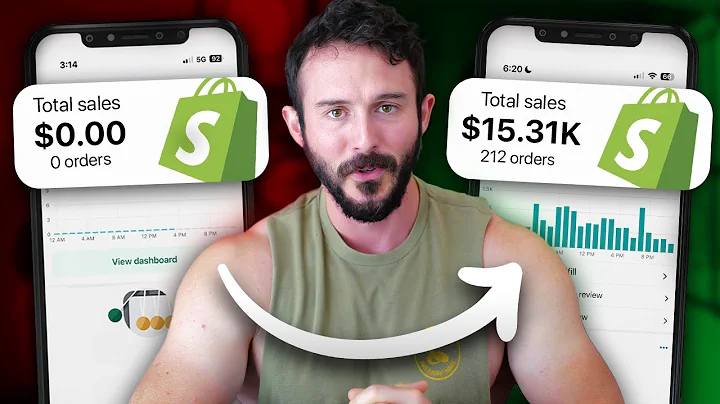The Truth About Amazon Dropshipping
Table of Contents
- Introduction
- What is Amazon Drop Shipping?
- Legality of Amazon Drop Shipping
- Finding a Drop Shipping Supplier
- Pros of Amazon Drop Shipping
- Cons of Amazon Drop Shipping
- Profitability of Amazon Drop Shipping
- Automation and Scaling
- Lessons from a Former Drop Shipper
- Conclusion
Introduction
In this article, we will be discussing the pros and cons of Amazon drop shipping, and helping you determine whether this ecommerce business model is worth pursuing. Drop shipping on Amazon involves selling physical products on the platform without the need to handle inventory, shipping, or customer service. It is considered one of the easiest ways to start a business selling online, with minimal upfront costs and low risk. However, there are certain factors to consider before diving in, as the Amazon drop shipping model has its own set of challenges and limitations. This article will provide a comprehensive analysis of the Amazon drop shipping business model, giving you a clear picture to make an informed decision. So, let's delve into the world of Amazon drop shipping and explore its potential benefits and drawbacks.
What is Amazon Drop Shipping?
Amazon drop shipping is a type of ecommerce business model where you sell physical products on Amazon without the need to handle inventory, shipping, or customer service. It involves partnering with a drop shipper who acts as your supplier. When you make a sale on Amazon, you simply notify your drop shipper, who then ships the products directly to the customer on your behalf. As a seller, you don't touch a single product in the process, and there are minimal upfront costs involved. The appeal of Amazon drop shipping lies in its low risk and ease of entry, making it accessible to anyone interested in starting an online business.
Legality of Amazon Drop Shipping
Before venturing into Amazon drop shipping, it is crucial to understand its legality. As per Amazon's guidelines, drop shipping is allowed on their platform, but certain rules must be followed to avoid getting banned. It is permitted to fulfill customer orders using a drop shipper, but you must always be the seller of record for your products. This means that all packaging, invoices, and other materials must identify you as the seller, not the drop shipper. It is essential to ensure that your supplier is a legitimate wholesaler and not another retailer. Violating any of Amazon's rules can result in account suspension, so it is crucial to abide by their code of conduct.
Finding a Drop Shipping Supplier
To engage in legitimate drop shipping on Amazon, it is important to find a reliable dropship supplier. There are several methods to connect with legitimate dropship suppliers:
-
Contact the distributor directly: Look up the manufacturer of the products you want to sell and reach out to their distributor. Inquire whether they have a drop shipping program in place.
-
Attend wholesale trade shows: Wholesale trade shows offer an opportunity to meet dropship wholesalers in various categories. By attending these shows, you can find multiple dropship suppliers in one place.
-
Use dropship directories: Websites like Worldwide Brands offer pre-vetted wholesale distributors that offer dropshipping services. Access to these directories often requires a one-time fee.
When choosing a dropship supplier, it is important to ask relevant questions such as drop ship fees, upfront payments, return policies, inventory data feed availability, branded packaging options, and support for electronic data interchange (EDI). Thoroughly researching and vetting potential suppliers is crucial to ensure a successful partnership.
Pros of Amazon Drop Shipping
-
Access to a large marketplace: With over 50% market share for ecommerce, Amazon offers a massive customer base and the potential for high sales volumes.
-
Easy setup and low entry barriers: Starting an Amazon drop shipping business does not require technical expertise or significant upfront investment. With an Amazon seller's account, you can start selling immediately.
-
Minimal risk and inventory management: As a drop shipper, you don't need to hold inventory or worry about cash flow, unsellable products, or clearance items. This reduces financial risk and allows for easy scalability.
-
Lower overhead costs: Drop shipping on Amazon eliminates the need for a website, hosting company, or conversion optimization. The costs associated with these aspects are minimized or eliminated altogether.
-
Branding opportunities: Amazon allows you to brand your packaging and inserts. This offers an opportunity to create brand recognition and loyalty, even within the drop shipping model.
Cons of Amazon Drop Shipping
-
Low profit margins: Drop shipping margins on Amazon can be razor-thin, often ranging from 10% to 30%. Coupled with Amazon's selling fees, there is limited room for significant profit.
-
Intense competition: As an Amazon drop shipper, you will be competing with other sellers for the buy box. Price becomes a major factor, often leading to a price spiral to the bottom.
-
Lack of control and customer data: Amazon restricts access to customer data, making it challenging to build meaningful relationships or engage in repeat business. This limits your ability to market directly to customers.
-
Dependency on suppliers: The success of your Amazon drop shipping business relies heavily on the reliability and efficiency of your dropship supplier. Any shortcomings or mistakes on their part can affect your entire operation.
-
Inability to sell the business: An Amazon drop shipping business is not a sellable asset, as you don't own the marketplace, customers, or products. This limits potential exit strategies.
Profitability of Amazon Drop Shipping
While Amazon drop shipping can be a profitable venture, it requires scalability and effective management to overcome the challenges associated with low profit margins and intense competition. To maximize profitability, it is crucial to automate various aspects of the business, such as purchase order creation, repricing, inventory management, product data syncing, and order tracking. Automation tools help streamline operations and free up time for strategic decision-making and growth.
Automation and Scaling
Automation is essential for the success of an Amazon drop shipping business. Managing a large number of products, monitoring pricing dynamics, and staying updated with supplier inventory levels require efficient software solutions. Amazon repricing tools, inventory management software, and order processing automation can greatly aid in scaling the business and improving profitability.
Lessons from a Former Drop Shipper
Numerous drop shipping businesses on Amazon have faced challenges and even account suspension due to various mistakes and limitations associated with the model. Learning from the experiences of those who have lived through the highs and lows of Amazon drop shipping can help aspiring entrepreneurs navigate the intricacies of the business.
Conclusion
Amazon drop shipping can be an appealing business model for those looking to start an online business with low upfront costs and minimal risk. However, it is essential to fully understand the pros and cons before diving in. The low profit margins, intense competition, lack of control over customer data, and dependence on suppliers pose significant challenges. To succeed in Amazon drop shipping, a strategic approach, automation, and scalability are crucial. By carefully considering all aspects and potential pitfalls, individuals can make informed decisions and determine whether Amazon drop shipping is the right path for their entrepreneurial journey.
Highlights:
- Amazon drop shipping is an ecommerce business model where you sell physical products on Amazon without handling inventory, shipping, or customer service.
- The model offers low upfront costs, minimal risk, and easy accessibility, making it appealing for beginners.
- Drop shipping margins on Amazon are low, making it challenging to generate significant profits.
- Amazon's high selling fees and intense competition contribute to the low profitability of drop shipping on the platform.
- Lack of control over customer data and dependence on suppliers are significant drawbacks of the Amazon drop shipping model.
- Automation and scalability are crucial for success in Amazon drop shipping.
- Learning from the experiences of others can help navigate the challenges and avoid potential pitfalls in drop shipping on Amazon.
FAQ:
Q: Is Amazon drop shipping legal?
A: Yes, Amazon drop shipping is legal as long as you follow Amazon's guidelines and ensure the appropriate seller identification and fulfillment procedures.
Q: Can I use any supplier for drop shipping on Amazon?
A: No, Amazon requires you to fulfill orders using a legitimate wholesaler or distributor. Drop shipping from other retailers or marketplace platforms is not permitted.
Q: What are the main challenges of drop shipping on Amazon?
A: The main challenges of drop shipping on Amazon include low profit margins, intense competition, limited control over customer data, and dependence on reliable suppliers.
Q: Can I build a long-term, branded business through drop shipping on Amazon?
A: Building a long-term, branded business can be challenging with Amazon drop shipping due to the limited control over customer data and the inability to establish direct relationships with customers. However, strategic branding efforts, such as branded packaging and inserts, can help create some brand recognition and loyalty.



















